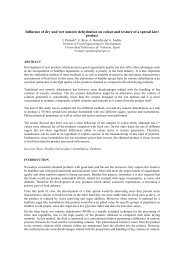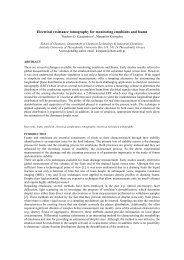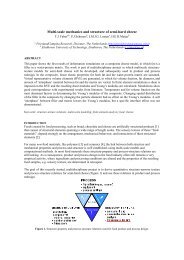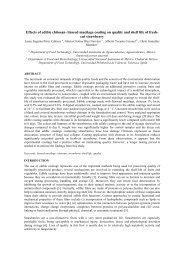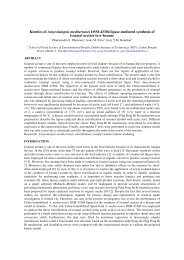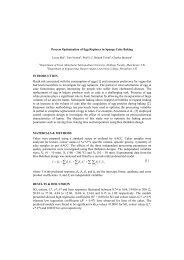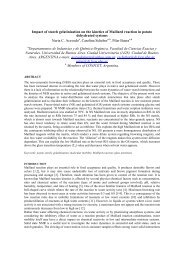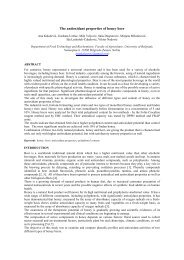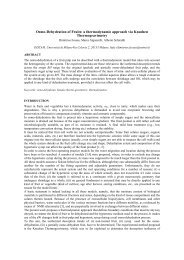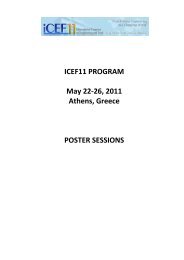Cereal Bar Development Using Exotic Fruit - 6 pages
Cereal Bar Development Using Exotic Fruit - 6 pages
Cereal Bar Development Using Exotic Fruit - 6 pages
Create successful ePaper yourself
Turn your PDF publications into a flip-book with our unique Google optimized e-Paper software.
The texture analyze results are presented in Table 4. The hardness values ranged between 942.01 (g) and<br />
1900.04 (g), but the values did not statistically different (p ≤ 0.05) among themselves. For the crispness<br />
attribute the change was 156.27 (g.s -1 ) 456.58 (g.s -1 ). The bars with jenipapo 5% and standard were similar<br />
when compared with commercial cereal bars. Comparing the sensory analysis for attribute texture and the<br />
instrumental value for this parameter, we can see that the cereal bar namely commercial 1 had the highest<br />
score for texture, but the value for hardness and crispness were the lowest values. As conclusion, the values<br />
of hardness and crispness influence in the acceptance of the cereal bars. Some authors have reported hardness<br />
values in their research. Paiva [16] obtained an average hardness of 1670.90 (g) for cereal bars based on the<br />
rice chimera and vegetable residues. Freitas [17] obtained an average hardness of 1182.7 (g) for cereal bars<br />
containing textured soy protein and wheat toasted germ, and Matsuura [8] obtained an average hardness of<br />
1701.26 (g) for cereal bars of passion fruit residues. These values were close to those found in this work.<br />
Table 4. Comparison of acceptability of cereal bars with different formulation, standard, commercial, 15% of<br />
jackfruit seed and 5% of jenipapo<br />
<strong>Cereal</strong> <strong>Bar</strong> Hardness (g) Crispness (g.s)<br />
Standard 1101.80±331.12 a<br />
294.72±6.57 c<br />
Commercial 1 942.01±245.92 a<br />
156.27±45.88 a<br />
Commercial 2 1900.04±254.51 b<br />
367.38±85.13 b,c<br />
Jack fruit seed 1137.42±275.19 a<br />
258.99±75.60 b<br />
Jenipapo 1794.93±572.12 b<br />
456.58±193.50 a,c<br />
* Values in a column not followed by the same letter are significantly different (p < 0.05)<br />
The centesimal composition of cereal bar is presented in Table 5. It is verified that the content total fiber of<br />
cereal bars formulated with jenipapo (5%) and jack fruit seeds (15%) were 19.2 and 25.5 times, respectively,<br />
higher than the cereal bar standard, and above 13.8 and 6.0 times when compare with cereal bars commercial<br />
1 and 2, respectively. Therefore, the cereal bars formulated in this work could be considered as foods rich in<br />
fiber. The protein content was very low (approximately 0.05 for all bars). The incorporation of exotic fruits<br />
allows smaller amounts of carbohydrates, a reduction of approximately 14% of energy. Some authors report<br />
their research in the physical-chemical values of cereal bars. Lima [5] using cashew to produce cereal bars,<br />
verified 7.40% of moisture, 9.73% of protein 1.63% of ash, 9.70% of lipids and 5.84% of fiber, Freitas and<br />
Moretti [15] produced cereal bars on the basis of textured soy protein and wheat germ, toasted, with values of<br />
10.71% moisture, 15.31% protein, ash 2 20%, lipid 5.64%, 5.17% fiber and 60.97 carbohydrates and<br />
Gutkoski [18] obtained cereal bars based-oats, the content was protein - 9.79%, lipid – 5.17%, fiber – 10.69%<br />
and carbohydrate - 58.88%. Compared these levels are close to those obtained with the bars formulated in<br />
this work, except to protein content.<br />
Table 5. Comparison of centesimal composition of cereal bars with different formulation, standard,<br />
commercial, 15% of jackfruit seed and 5% of jenipapo.<br />
Composition Standard Commercial 1 Commercial 2 Jack fruit seed Jenipapo<br />
Moisture (%) 21,82 ± 0,14 a,c 15,40 ± 1,26 b 18,99 ± 2,59 b,c 23,46 ± 0,61 a 18,56 ± 0,52 b,c<br />
Ash (%) 0,88 ± 0,01ª ,c 1,20 ± 0,01 b 1,42 ± 0,01 c 0,89 ± 0,02 a 0,75 ± 0,05 d<br />
Protein (%) 0,04 ± 0,00 a 0,05 ± 0,00 a<br />
0,05 ± 0,00 a 0,05 ± 0,01 a 0,03 ± 0,00 a<br />
Lipid (%) 3,35 ± 0,14 b 10,45 ± 0,44 d 6,66 ± 1,52 c 4,27 ± 0,27ª ,b,c 3,61 ± 0,25 a,b<br />
Fiber (%) 0,61 ± 0,04 a 0,85 ± 0,19 a 1,81 ± 0,14 b 11,72 ± 0,32 d 15,47 ± 0,25 c<br />
Carbohydrate (%) 73,31 ± 0,20 71,68 ± 1,51 71,08 ± 3,01 59,61 ± 0,74 61,61 ± 0,63<br />
Energy (Kcal.100g -1 ) 323,50 ± 0,58 380,96 ± 3,29 344,42 ± 7,55 277,02 ± 1,68 278,99 ± 1,48<br />
* Values in a line not followed by the same letter are significantly different (p < 0.05)<br />
COCLUSIO<br />
The highest incorporation of jenipapo and jackfruit seed in cereal bars, with greater sensory acceptance, were<br />
5% and 15% respectively. The comparison of the textures, physic-chemical and sensory characteristics of the<br />
cereal bars formulated with exotic fruits and the standard and commercial cereal bars indicate that the exotic<br />
raw materials can be use to formulated cereal bars, besides the reduction approximately 14% of caloric value<br />
and increase the content fiber in the cereal bar.



